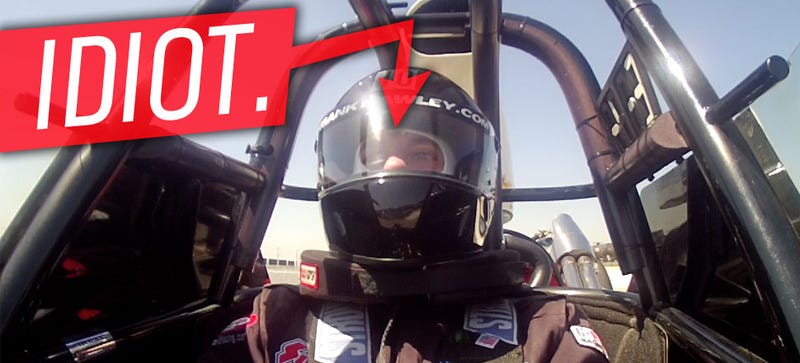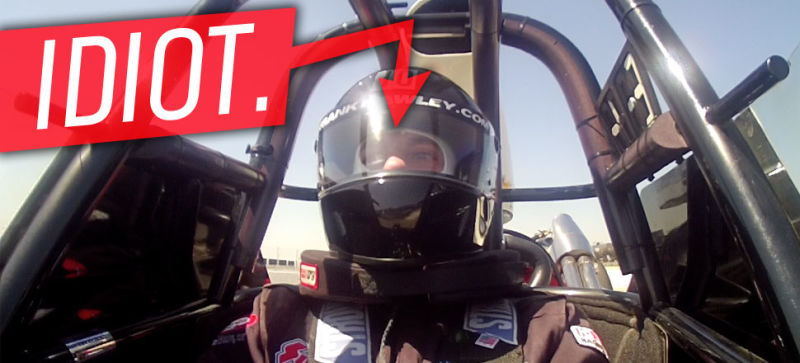
Let’s just get this out of the way right off the bat: I’m an idiot. I’m a big dumb idiot who made a stupid mistake and got lucky that something really bad didn’t happen. I’m hoping I can use my idiocy for some good, though, and dispel some myths about drag racing. Because drag racing deserves your respect.
Advertisement
Of all forms of motorsport, drag racing seems to be the one that almost anybody thinks they could just do because, on the surface, it looks so easy. It’s just driving in a straight line, right? How hard could it be?
And, sure, on a very basic level, it’s not hard. It’s by far the most accessible form of motorsport to people, and that’s a very good thing. But once you get past that most basic, show-up-at-the-dragstrip-and-see-what-happens-level, you realize this is not an easy sport at all. It’s a surprisingly nuanced and demanding sport, and it’s absolutely worthy of your respect.
Advertisement
I learned this hard and humbling lesson at Frank Hawley’s Drag Racing School’s media day, where award-winning (hypothetical awards, of course) journalists like myself can get some time in a real, open-wheel dragster.
These are training dragsters, of course, having automatic transmissions and somewhat less power than a real, grown-up dragster, but don’t take that to mean that these cars are anything but real. They still are putting out about 550 HP from a massive Chevy V8 engine right behind your head, and there’s huge fat tires at the rear and tiny bike-looking wheels way, way up front. It’s a dragster.
Frank Hawley himself is one of the NHRA’s top 50 drivers of all time, and a terribly nice guy on top of all that. Which is partially why when I made my stupid error I felt so bad, because it had that sort of “I’ve disappointed dad” feeling on top of everything when he had to tell me I couldn’t drive anymore that day. Ugh.
Before I describe my stupid mistake, let’s just get some fundamentals of drag racing down. The interesting aspect of the sport has to do with the degree to which it’s a study in extremes. You’re either inching the car along to line it up with a surprising degree of precision on the track or you’re jamming your foot down and going full batshit fast. There’s very little in between.
Advertisement
Sponsored
It’s sort of like if there was a sport that had you build a ship in a bottle with glue and tweezers, and then blow it up. All while being timed.
The races are like that because the initial part, the part before you’re technically racing at all, is really quite important. It’s the staging portion of the race. You need to get those front wheels of the dragster breaking two infra-red beams. One is for the pre-staging position, and one for the final staging position.
There’s a surprising amount of strategy involving how you stage your car — it can affect the overall results of the race in important ways. When you’re dealing with wins or losses that are measured in thousandths of a second, every little bit counts. “Shallow” staging may give you better elapsed times but worse reaction times, for example, and both of those are factors. We only barely scratched the surface of what this involves, but it’s significant.
Advertisement
The reaction time is important as well, and is one of those things you develop with practice. You’re on a hair trigger at the start of the race, and you want to translate that potential explosion of speed and adrenalin into a quick time and not a jump start before the light or a bunch of speed-wasting wheelspin, among other things. It’s not easy.
The physical act of driving the Dragster itself is probably not so different from what you may imagine. You cram into it sort of like how you’d cram a kitten into a shoe — with a good amount of difficulty, and awkward limb placement, but eventually you end up pretty snug. It’s not uncomfortable in there, but I’m not a big guy, and I’m sure if you’re a more substantial person, it could be pretty claustrophobic.
The pedals are on either side of the steering column — which itself is topped with a strangely tiny, butterfly-shaped wheel — and it’s one foot per pedal, so, left-foot braking. The shifter is close up against the right-side wall (though it was solenoid-operated here) and to the left is the parachute release we were asked not to touch (sure was tempting, though).
The wildly long hood and tiny front wheels make it not the best maneuvering car you’ll be in, but it’s not as bad as I thought it would be beforehand, especially when driving it around the track to return to the starting line. The track itself is like walking on flypaper — incredibly sticky. If you were wearing flip-flops, they’d still be there on the track, baking into the surface for alien archeologists to dig up in a millennia after we have that mishap with the Large Hadron Collider.
Advertisement
Advertisement
The basic rules of drag racing were sensible, and some were familiar from other track work I’ve done: look ahead to where you want to go (the finish), keep it pointed straight, keep a light touch on the wheel, and know where you are on the track. I broke one of those rules.
Once on the track and at speed, the dragster goes like a dart. You do some steering correcting, but it’s very minor and basically automatic. I didn’t have any issues keeping the car pointed nice and straight, but I did have one big problem that speaks to what makes the whole sport so challenging.
First, I should mention that up until this point I was only on an actual drags trip once before, running some electric cars down the 1/8 mile strip at Irwindale. The 1/8 part is the take-away there.
My first run, a 1/8th mile drag, was fine, but I found myself unconsciously lifting during acceleration. So, I decided that for my next run, the full 1/4, I was going to try and make sure not to lift like that. That’s not a bad idea, as such, but my initial focus on that as a goal sowed the seeds of my idiocy.
Advertisement
When the 1/4 race came, everything started just fine. I even had a pretty good reaction time of 0.156. I focused on not lifting, and I was taken in by the noise, the roller-coaster-like feeling of acceleration, and the sheer speed. It was an absolute blast.
The mistake I made happened really, really quickly. As I was going, I let my concentration falter at just the wrong time, which meant I didn’t register where the finish line was. I blew right past it. And since I wasn’t familiar with a full 1/4 run, I overestimated the length and kept on the throttle way, way too long.
Advertisement
All of these things happened in time measured in seconds at the very most, and the real error was over and done in a fraction of a second. I was, essentially, lost on a 1/4 mile straight stretch of road, which sounds absurd, but that’s essentially what happened. I should have noted I passed the finish, I should have noticed sooner the track surface changed, I should have been more aware of the elapsed time.
Eventually, I did realize, and that rapidly-approaching hill at the end of the track helped remind me. I got on the brakes, and then progressively got on them a bit harder as the emergency run-off gravel pit grew larger and larger.
My three rules for any track event I go to are Don’t Wreck The Car, Don’t Be A Jerk, and Try Not To Come In Last. And I realized I was in grave danger of breaking all three. Luckily, I managed to get the dragster to a stop a few scary feet in front of the pit, and everything was fine — no damage to me or the car, except for a nasty dent in my ego.
Advertisement
Unlike many stupid mistakes in my life, this one I have on video, which is a pretty mixed blessing:
I felt like an ass. I realized exactly what I’d done right after I did it, and even though I was absolutely certain I wouldn’t make that mistake again, the damage was done. This is one of those insta-get-out-of-the-car offenses, and they’re absolutely right to do so. It’s dangerous.
Advertisement
Having Frank tell me I was done driving for the day, as nice as he was about it, still made me feel awful. I apologized right after my run, even before they came to me, because I knew what happened. It did help that I wasn’t the only one to fall into this trap — a Formula D driver managed it as well, among a couple others — but it wasn’t, of course, where I wanted to be.
Some experienced drag racers there told me about similar things they’d done — my face is a pretty transparent indicator of shame, I think — and all this made me realize the true challenge of the sport: the time compression.
Advertisement
Every form of racing can be brutal to the failings of being a human, but none is as cruel when it comes to time as drag racing. Everything happens so fast, in such a compressed way, that almost any little mistake, any loss of focus, any misplaced step has enormous consequences. There isn’t any time for recovery in a drag race — everything you do in that race has to be the right thing, or at best you end up losing, and at worst you end up on fire or something.
So, Drag Racing, you’ve made your point. You’re a worthy adversary, and you have my respect. I’m still really happy I had this opportunity to try, and even though I screwed up, I think I really did learn a great deal. If this were an Afterschool Special (and maybe it should be) here’s where I’d tell you that I did a lot of growing up that day.
I’m going to try again at some point. And I’m pretty sure I won’t make this mistake again. I just wonder what the new mistake will be.













